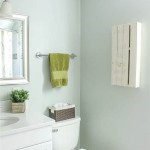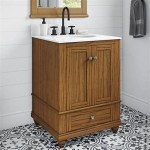Bathroom Ceiling Lights: A Guide to Flush Mount Options
Bathroom lighting is a critical element of bathroom design, impacting both functionality and aesthetics. The selection of appropriate lighting fixtures contributes to a well-lit and visually appealing space, enhancing daily routines such as grooming and cleaning. Flush mount ceiling lights are a popular choice for bathrooms, offering a low-profile design that is suitable for various ceiling heights and bathroom sizes. These fixtures sit directly against the ceiling, maximizing headroom and providing ambient illumination.
This article explores the key considerations when selecting bathroom ceiling lights, specifically focusing on flush mount options. The information provided covers design characteristics, functionality, installation notes, and safety considerations to enable informed decision-making.
Understanding Flush Mount Light Fixtures
Flush mount ceiling lights are characterized by their direct attachment to the ceiling surface. This design eliminates any gap between the fixture and the ceiling, creating a clean and seamless appearance. Their low profile makes them a practical choice for bathrooms with lower ceilings, preventing the feeling of a cramped or restricted space. Furthermore, because the fixture is close to the ceiling, it reduces the likelihood of accidental contact, an important aspect in high-traffic areas such as bathrooms.
Flush mount lights are available in a wide range of styles, from simple and minimalist designs to more decorative options with intricate detailing. The housing material can vary, including metal, plastic, and glass, each offering different aesthetic and durability characteristics. Glass diffusers, a common feature in flush mount lights, are designed to evenly distribute light and reduce glare, contributing to a comfortable and well-lit environment. The choice of diffuser material and design can significantly impact the quality and direction of the light emitted.
Semi-flush mount lights are a variation on the flush mount design. These fixtures hang slightly lower than true flush mounts, typically by a few inches. This small gap can provide a more decorative look and allow for more elaborate designs. However, semi-flush mounts are only suitable for bathrooms with higher ceilings, as they can still reduce headroom in smaller spaces. The selection between a flush mount and semi-flush mount depends on the ceiling height, desired aesthetic, and overall bathroom design.
Key Considerations for Selecting Flush Mount Bathroom Lighting
Several factors influence the selection of appropriate flush mount bathroom lighting. These considerations include the size of the bathroom, the desired light output, the style of the bathroom, and the required safety ratings.
Bathroom Size and Light Output: The size of the bathroom directly impacts the required light output. Larger bathrooms necessitate more light fixtures or fixtures with higher lumen output to ensure adequate illumination. Conversely, smaller bathrooms may only require a single, smaller flush mount fixture. It is essential to consider the overall dimensions of the space when determining the number and wattage of lights required. This can be calculated using the bathroom's square footage and multiplying it by a recommended foot-candle level for bathrooms (typically between 50 and 70 foot-candles). The lumen output of the chosen fixture should then correspond to the calculated foot-candle requirement.
Style and Design: The style of the flush mount light should complement the overall design of the bathroom. Whether the bathroom is modern, traditional, or minimalist, the lighting fixture should integrate seamlessly with the existing decor. Flush mount lights are available in various finishes, including brushed nickel, chrome, oil-rubbed bronze, and white. Selecting a finish that matches or complements other bathroom fixtures, such as faucets and cabinet hardware, creates a cohesive and visually appealing space. The shape and design of the diffuser should also be considered. Simple, round or square diffusers offer a clean and modern look, while more ornate designs can add a touch of elegance and sophistication.
Light Color Temperature: The color temperature of the light emitted by the fixture is another crucial consideration. Color temperature is measured in Kelvin (K) and ranges from warm (2700K-3000K) to cool (4000K-5000K) and daylight (6000K-6500K). Warm light creates a cozy and relaxing atmosphere, suitable for creating a spa-like environment. Cool light provides a brighter and more energizing feel, ideal for tasks such as applying makeup and shaving. Daylight is closest to natural sunlight and provides accurate color rendering. The ideal color temperature for a bathroom depends on personal preference and the intended use of the space. A common approach is to use a warmer color temperature for general ambient lighting and a cooler color temperature for task lighting around the vanity.
Energy Efficiency: The energy efficiency of the light fixture is also a relevant consideration. LED (light-emitting diode) bulbs are significantly more energy-efficient than traditional incandescent or halogen bulbs. LED bulbs consume less energy and have a longer lifespan, resulting in lower energy bills and reduced maintenance costs. When selecting a flush mount light, opting for one that uses LED bulbs or has integrated LED technology can provide long-term cost savings and environmental benefits. It's important to check the Energy Star rating of the fixture to ensure its energy efficiency.
Safety and Installation Considerations
Bathroom lighting requires adherence to specific safety regulations due to the presence of water and electricity. The National Electrical Code (NEC) outlines guidelines for electrical installations in wet and damp locations, including bathrooms. Flush mount ceiling lights installed in bathrooms must be rated for damp locations, meaning they are designed to withstand moisture exposure. Fixtures installed directly above a bathtub or shower require a wet location rating, indicating they can withstand direct water exposure.
IP Ratings: In addition to the NEC guidelines, Ingress Protection (IP) ratings provide a standardized measure of a fixture's protection against solids and liquids. An IP rating consists of two digits: the first digit indicates protection against solid objects, and the second digit indicates protection against liquids. For bathroom lighting, an IP44 rating or higher is generally recommended, indicating protection against splashing water. Fixtures installed directly above a bathtub or shower may require a higher IP rating, such as IP65, which provides protection against water jets.
Professional Installation: While some homeowners may be comfortable installing lighting fixtures themselves, it is generally recommended to hire a qualified electrician for bathroom lighting installations. Electrical work can be dangerous, and improper installation can lead to electrical shocks, fires, or damage to the electrical system. A licensed electrician has the knowledge and experience to ensure the lighting is installed safely and in compliance with all applicable codes. Furthermore, an electrician can properly ground the fixtures and ensure the wiring is correct, minimizing the risk of electrical hazards.
Ground Fault Circuit Interrupters (GFCIs): Bathroom circuits should be protected by Ground Fault Circuit Interrupters (GFCIs). GFCIs are designed to detect small imbalances in electrical current, which can indicate a ground fault. When a ground fault is detected, the GFCI quickly interrupts the circuit, preventing electrical shocks. All electrical outlets and lighting fixtures in bathrooms should be connected to a GFCI-protected circuit. GFCI outlets are easily recognizable by their test and reset buttons. Regularly testing the GFCI outlets can ensure they are functioning correctly and providing the necessary protection.
Dimmer Switches: Installing dimmer switches allows for adjusting the light level in the bathroom, creating a more versatile and customizable lighting experience. Dimmer switches are particularly useful in bathrooms, where the desired light level may vary depending on the time of day and the activity being performed. For example, a lower light level may be preferred for relaxing in the bathtub, while a brighter light level is needed for applying makeup. When selecting dimmer switches, it is important to choose those that are compatible with the type of light bulbs being used. LED-compatible dimmer switches are specifically designed to work with LED bulbs, preventing flickering or buzzing. It's also crucial to ensure that the dimmer switch is rated for the wattage of the lighting fixture.
In summary, Flush mount ceiling lights provide a practical and aesthetically pleasing lighting solution for bathrooms. By carefully considering the size of the bathroom, the desired light output, the style of the bathroom, and the required safety ratings, homeowners can select the appropriate flush mount lighting fixtures to enhance the functionality and ambiance of their bathrooms. Prioritizing safety and adhering to electrical codes is paramount during installation to ensure a safe and reliable lighting system.

Modern Flush Mount Lighting West Elm

Flush Mount Bathroom Lighting Ceiling Lights Lumens

Ashley Bathroom Ceiling Flush Mount Light 3x60w E27 In Polished Chrome The Lighting

The Chicest Flush Mount Lighting Trusted Favorites And Stylish Picks Zhush

Lamqee Crystal 8 7 In Watt Chrome Integrated Led Flush Mount Round Ceiling Light For Kitchen Bedroom Bathroom Hallway 06ftl0173abk The Home

Flush Mount All Bath Lighting Pottery Barn

Flush Mount Bathroom Lighting Ceiling Lights Lumens

Flush Mount Led Ceiling Light Fixture 24w 2400lm Waterproof Ip65 Lamp Surface Round Lighting For Bathroom Kitchen Bedroom Black Com

Commercial Electric 7 In White Round Closet Light Led Flush Mount Ceiling 810 Lumens 4000k Bright Bathroom Laundry Room 54663141 The Home

Flush Mount Bathroom Lighting Ceiling Lights Lumens
See Also







